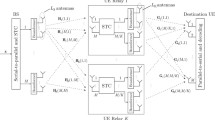Abstract
Multiple Input Multiple Output (MIMO) systems employ multiple antennas to provide high spectral efficiency and wireless link reliability thanks to multipath diversity and space multiplexing. This technology is now being implemented into wireless standards such as 802.11n, as well as the 4th generation cellular networks. In this paper we present results of an extensive simulation research in which we compare three receiver models for MIMO WLAN 802.11n system. We investigate maximum-likelihood, zero-forcing and Vertical Bell Laboratories Layered Space Time receivers. Performance of these receivers for a range of 802.11n environments, i.e. for several channel models and different number of transmitter and receiver antennas is evaluated. The results of the comparison highlight the benefits of MIMO technology and show to what extent it is possible to improve the MIMO 802.11n system performance increasing the receiver complexity.
Similar content being viewed by others
References
Foschini G. J., & Gam M. J. (1996) Layered space-time architecture for wireless communication in a fading environment when using multiple antennas. Bell Labs Technical Journal 1: 41–59
Bäolcskei, H., & Paulraj, A. J. (2002). Multiple-input multiple-output (MIMO) wireless systems (2nd ed. pp. 90.1–90.14). Boca Raton, FL: CRC Press.
IEEE Draft Std P802.11n_D3.00. (2007).
Wolniansky, P. W., Faschini, G. J., Golden, G. D., & Valenzuela, R. A. (1998). V–BLAST: An architecture for realizing very high data-rates over the wireless channel. Proceedings on IEEE ISSSE-98, Pisa, Italy.
Golden G. D. et al (1999) Detection algorithm and initial laboratory results using V–BLAST space-time communication architecture. Electronic Letters 35: 14–16
IEEE P802.11 Wireless LANs, TGn Channel Models, IEEE 802.11-03/940r4. (2004).
Krasicki, M. (2010). Iterative receiver for wireless computer networks. PhD dissertation. Poznan University of Technology.
Perahia E., Stacey R. (2008) Next generation wireless LANs. Cambridge University Press, Cambridge, pp 50–51
Author information
Authors and Affiliations
Corresponding author
Rights and permissions
About this article
Cite this article
Kotrys, R., Krasicki, M., Remlein, P. et al. Receiver Algorithms for Multi-stream Data Transmission in WLAN 802.11n Networks. Wireless Pers Commun 68, 1583–1594 (2013). https://doi.org/10.1007/s11277-012-0540-7
Published:
Issue Date:
DOI: https://doi.org/10.1007/s11277-012-0540-7




